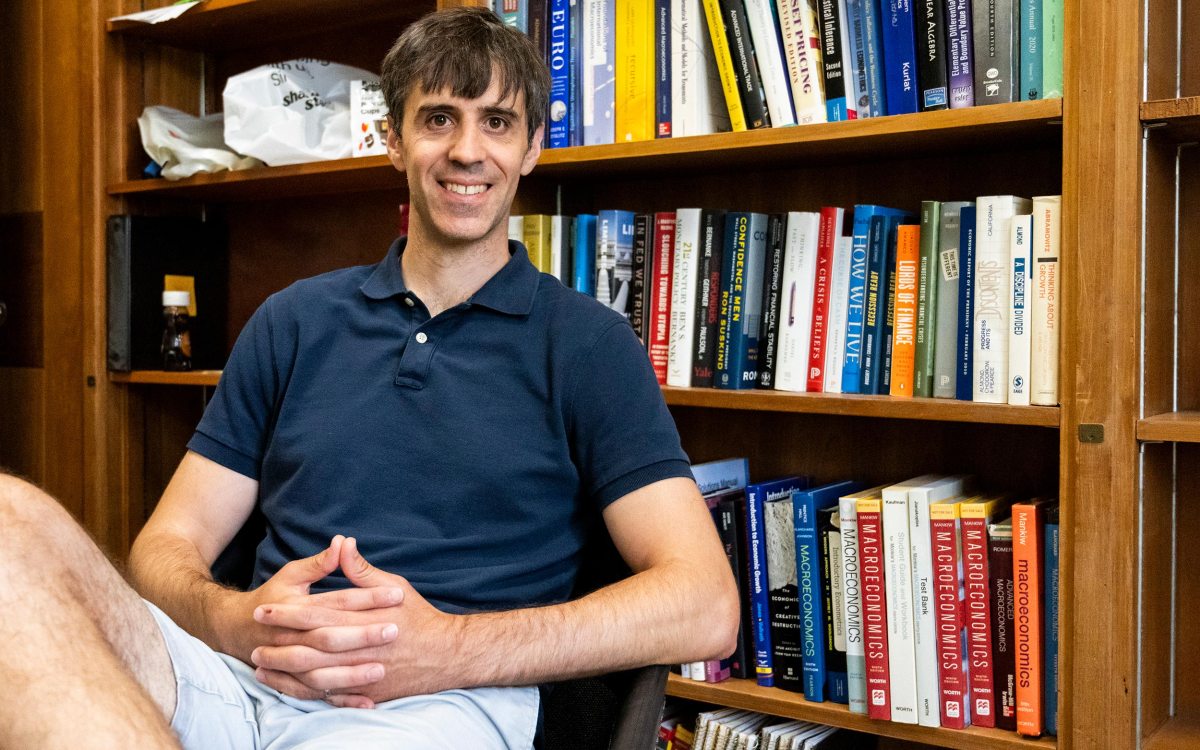
Illustration by Judy Blomquist/Harvard Staff
More educated communities tend to be healthier. Why? Culture.
New study finds places with more college graduates tend to develop better lifestyle habits overall
Having more education has long been linked to better individual health. But those benefits are also contagious, say the co-authors of a new working paper.
“It’s not just that the individuals who have more years of education are in better health,” said David M. Cutler, Otto Eckstein Professor of Applied Economics. “It’s that even people with fewer years of education — for example, people with just a high school degree — are in better health when they live around people who have more years of education.”
The paper examines why cities with more college graduates see lower mortality rates for residents overall. It’s not due to spatial sorting, or the practice of relocating to live amidst those with similar habits. Nor did the researchers find a particularly strong correlation with factors like clean air, low crime, and high-quality healthcare infrastructure. Instead, most of the explanation involves rates of smoking, physical activity, and obesity.
The pattern has everything to do with a community’s common culture, said co-author Edward L. Glaeser, the Fred and Eleanor Glimp Professor of Economics and chair of the Department of Economics. “Smoking, for example, is a social activity,” he said. “Fundamentally, being around other smokers is fine if you’re smoking, but it’s usually pretty unpleasant if you’re not smoking.”
Every 10 percent increase in area’s college grads linked to …Source: Human Capital Spillovers and Health: Does Living Around College Graduates Lengthen Life?
Glaeser, an urban economist and author of “Triumph of the City” (2011), has spent decades studying how varying education levels play out across U.S. society. One well-established finding concerns economic resilience. “If you ask yourself, which American cities managed to turn themselves around after the very difficult period of the 1970s and 1980s? Educated places like Seattle or Boston did. Less-educated places did not,” Glaeser said.
For his part, Cutler, a health economist, spent the last few decades parsing the strong link between education and individual health outcomes. All the while he kept collaborating with Glaeser to explore obesity, smoking, and other health-related behaviors at the community level. The economists revisited these issues in the book “Survival of the City: The Future of Urban Life in an Age of Isolation” (2021).
Also collaborating on the new paper were Jacob H. Bor, an associate professor of global health at Boston University, and Ljubica Ristovska, a postdoctoral fellow at Yale. Together, the researchers rejected the spatial sorting explanation with the help of data from the University of Michigan’s Health and Retirement Study. Similar analysis was done using data from the National Longitudinal Surveys of young women and men. Results showed that unhealthy people of all ages relocate more frequently than healthy ones. But both groups settle in areas with roughly equal levels of human capital (defined here as a population’s years of education).
The team analyzed a variety of information sources — from county-level homicide statistics to regional estimates of air quality and a federal measure of hospital quality — to see whether mortality differentials are due to area amenities. “We estimate that at most 17 percent of the human capital externality on health is due to these external factors, driven largely by greater use of preventative care,” the co-authors wrote.
Instead, the majority of the correlation between human capital and area health — at least 60 percent — is explained by differences in health-related behaviors, the researchers found. Combining data from both the U.S. Census Bureau and Centers for Disease Control and Prevention revealed that every 10 percent increase in an area’s share of college graduates was associated with an annual 7 percent decrease in all-cause mortality.

Study authors David M. Cutler (left) and Edward L. Glaeser.
Kris Snibbe/Harvard Staff Photographer
With additional data from the CDC’s Behavioral Risk Factor Surveillance System and the Census Bureau’s Current Population Survey (CPS), the researchers were able to probe connections between human capital and various health-related behaviors. Every 10 percent increase in an area’s college graduates was associated with a 13 percent decrease in smoking, a 7 percent decrease in having no physical activity, and a 12 percent decrease in the probability of being very obese.
“It really opens up all these questions of how people form their beliefs,” Cutler said.
The paper went deepest on smoking, given the wealth of historical numbers on cigarette initiation, cessation, and beliefs. CPS data showed that in cities where people have more years of education — New York City, Boston, or Seattle, for example — people are more likely to think that smoking is bad for you. Residents of these cities are also likelier to support smoking regulations. For every 10 percent increase in bachelor’s degrees, the probability of working at a place with a complete smoking ban increases by 2 percentage points.
Cutler and Glaeser were especially fascinated to find a growing connection over time between human capital and area health, especially between the years 1990 and 2010. As the correlation between individual education and behavior increased, they explained, the relationship between a community’s education levels and its mortality rates slowly followed suit.
“Just look at people who were 70 in 2000,” said Glaeser, who has observed a similar dynamic over the same period between human capital and earnings. “These people were 30 in 1960. A lot of people were smoking in 1960, and there wasn’t nearly as strong of an education gradient as we saw 30 years later.”




